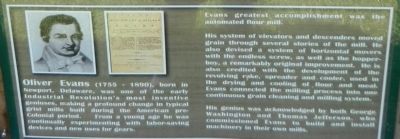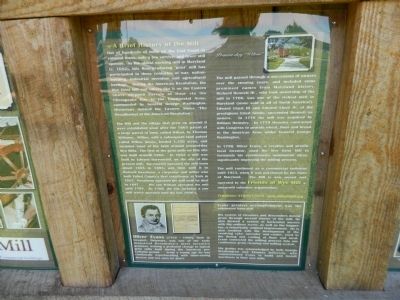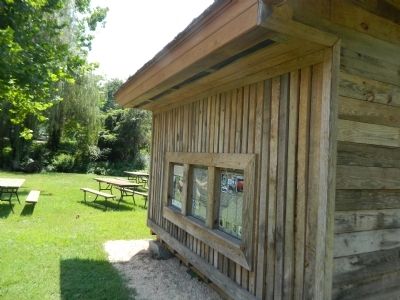Wye Mills in Talbot County, Maryland — The American Northeast (Mid-Atlantic)
A Brief History of the Mill
The Mill and the village that grew up around it were established soon after the 1665 patent of a large parcel of land, called Wilton, by Thomas Williams. Wilton, with a subsequent land patent called Wilton Annex, totaled 1,350 acres, and included most of the land around present-day Wye Mills. The first of the grist mills on this site was built around 1668. In 1682 a mill was built by Edward Barrowcliff, on the site of the present mill. Barrowcliff operated the mill from about 1683 to 1693, and then sold it to Richard Sweatnam, a carpenter and miller who built Talbot County's first courthouse at York in 1682. Sweatnam operated the mill until he died in 1697. His son William operated the mill until 1703. By 1706, the site included a saw mill, which operated until the late 1800's.
The mill passed through a succession of owners over the ensuing years, and included some prominent names from Maryland history. Richard Bennett III, who took ownership of the mill in 1706, was one of the richest men in Maryland (some said in all of North America!). Edward Lloyd III and Edward Lloyd IV, of the prestigious Lloyd family, succeeded Bennett as owners. In 1778 the mill was acquired by William Hemsley. In 1779 Hemsley contracted with Congress to provide wheat, flour and bread to the American Army under George Washington.
In 1790, Oliver Evans, a creative and prolific local inventor, used the Wye Grist Mill to formulate his revolutionary automation ideas, significantly improving the milling process.
The mill continued as a commercial endeavor until 1953, when it was purchased by the State of Maryland. The Mill is now owned and operated by the Friends of Wye Mill, a non-profit volunteer organization.
Telephone: 410-827-3850 www.oldwyemill.org
Erected by Friends of Wye Mill.
Topics. This historical marker is listed in these topic lists: Colonial Era • Industry & Commerce • Settlements & Settlers • War, US Revolutionary. A significant historical year for this entry is 1665.
Location. 38° 56.5′ N, 76° 4.875′

Photographed By Nate Davidson, August 2, 2013
2. Oliver Evans
Oliver Evans (1755-1790), born in Newport, Delaware, was one of the early Industrial Revolution's most inventive geniuses, making a profound change in typical grist mills build during the American pre-Colonial period. From a young age he was continually experimenting with labor-saving devices and new uses for gears.
Evans greatest accomplishment was the automated flour mill. His system of elevators and descenders moved grain through several stories of the mill. He also devised a system of horizontal movers with the endless screw, as well as the hooper-boy, a remarkably original improvement. He is also credited with the development of the revolving rake, spreader and cooler, used in the drying and cooling of flour and meal. Evans connected the milling process into one continuous grain cleaning and milling system.
His genius was acknowledged by both George Washington and Thomas Jefferson, who commissioned Evans to build and install machinery in their own mills.
Other nearby markers. At least 8 other markers are within walking distance of this marker. So, How Does a Mill Work? (here, next to this marker); Wye Grist Mill (here, next to this marker); a different marker also named The Wye Grist Mill (a few steps from this marker); Wye Grist Mill and Museum (within shouting distance of this marker); The “Little House” in the Shade (approx. 0.2 miles away); Wye Oak House (approx. 0.2 miles away); Wye Oak (approx. 0.2 miles away); Preserving a Legacy (approx. 0.2 miles away). Touch for a list and map of all markers in Wye Mills.
Credits. This page was last revised on June 16, 2016. It was originally submitted on August 4, 2013, by Nathan Davidson of Salisbury, Maryland. This page has been viewed 548 times since then and 43 times this year. Photos: 1, 2, 3. submitted on August 4, 2013, by Nathan Davidson of Salisbury, Maryland. • Bill Pfingsten was the editor who published this page.

